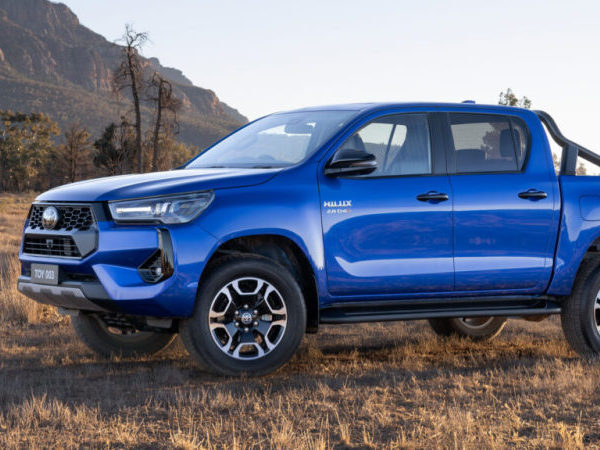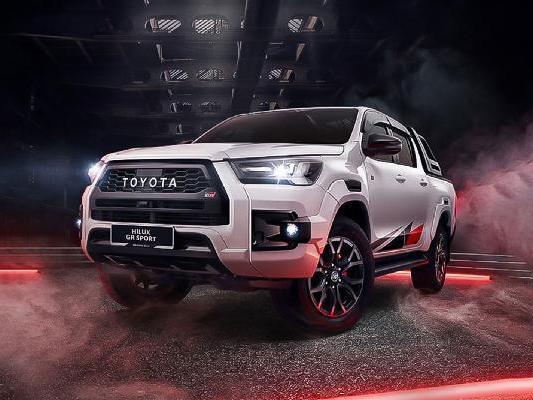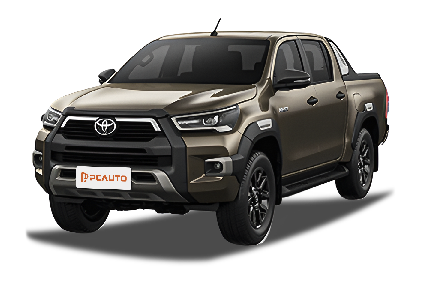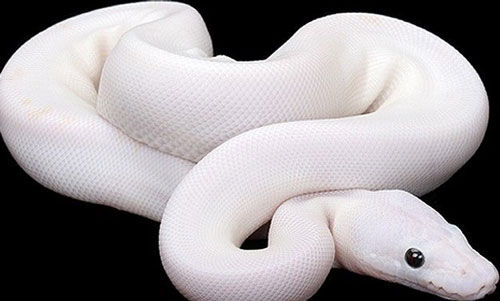Q
Which is better, Hilux or Navara?
The Hilux and Navara each have their own advantages, making it challenging to determine which is better. The Hilux offers various power options, including 2.4L and 2.8L diesel engines, with the 2.8L variant providing a robust 204 PS of power, making it capable of effortlessly handling heavy loads and challenging terrains. Its four-wheel-drive system and impressive ground clearance—some models boasting a minimum clearance of 286mm—contribute to its excellent off-road capability. The interior is spacious and practical, with seating designed to accommodate both passengers and cargo needs. Its reliability has been validated over years in the market, and it benefits from a widespread maintenance network.
On the other hand, the Navara also excels in power and off-road performance, with an interior focused on comfort and cutting-edge technology. It comes equipped with a wealth of features, delivering a pleasant driving experience.
If you prioritize power, durability, and high off-road performance in challenging conditions, the Hilux is an excellent choice. However, if interior comfort and technological features are more important to you, the Navara may better meet your needs.
Special Disclaimer: This content is published by users and does not represent the views or position of PCauto.
Related Q&A
Q
Is a 2018 Hilux reliable?
The 2018 Toyota Hilux has built a solid reputation in Malaysia for its reliability and durability. Under the hood, you'll find either a 2.4-liter or 2.8-liter turbocharged diesel engine—proven powertrains that deliver consistent performance, easily handling Malaysia's diverse road conditions whether you're navigating city streets or tackling rough rural tracks. The Hilux's tough chassis and practically tuned suspension can handle heavy loads, making it a great fit for both work and family use. Toyota's extensive after-sales network across Malaysia means maintenance is a breeze with readily available parts, really enhancing the long-term ownership experience. On top of that, the Hilux holds its value well in the used car market, a clear sign that buyers trust its quality. If you're in the market for a tough pickup with reasonable running costs, the 2018 Hilux is definitely worth a look. Of course, when buying used, it's always smart to check the service records and actual condition to make sure it performs as expected.
Q
What kind of engine is in the 2018 Toyota Hilux SR5?
The 2018 Toyota Hilux SR5 is powered by the 2GD-FTV 2.4-liter turbocharged diesel engine. This four-cylinder diesel unit features common rail direct injection and a variable geometry turbocharger (VGT), pushing out 150 horsepower (110 kilowatts) and 400 Newton-meters of torque. Paired with a 6-speed automatic or manual transmission, it strikes a solid balance between performance and fuel efficiency, making it a great fit for Malaysia's diverse driving conditions – think city commutes and light off-roading. Part of Toyota's GD engine family, this powerplant is known for its reliability and low maintenance costs, while also meeting the strict emissions standards of its time. What really stands out is the diesel's strong low-end torque, which makes the Hilux shine when hauling loads or climbing hills. Toyota's D-4D technology also helps optimize combustion efficiency and keep carbon buildup in check. For Malaysian drivers who often hit the highway or need serious load-carrying capability, this powertrain is a practical choice. Plus, Toyota's well-established after-sales service network locally adds to the overall convenience of ownership.
Q
What is the fuel consumption of the 2018 Toyota Hilux?
The fuel efficiency of the 2018 Toyota Hilux varies depending on engine configuration and driving conditions. Models equipped with the 2.4-liter turbo diesel engine (2GD-FTV) have a combined fuel consumption of approximately 7.5 to 8.0 liters per 100 kilometers, while the 3.0-liter turbo diesel version (1KD-FTV) is slightly higher, around 8.0 to 8.5 liters per 100 kilometers. Actual fuel consumption may fluctuate based on load, road conditions, and driving habits. For Malaysian users, the Hilux's diesel engine design is well-suited to local needs of mountainous roads and long-distance driving, with its low-rev high-torque characteristics maintaining fuel efficiency when climbing hills or carrying cargo. To further optimize fuel consumption, it is recommended to perform regular maintenance (such as cleaning the air filter and maintaining proper tire pressure) and adopt a smooth acceleration driving style, avoiding sudden braking and rapid starts. As a popular model in the pickup truck market, the Hilux's durability and fuel economy have always been among the reasons favored by Malaysian consumers. Additionally, Toyota's after-sales network across the country provides convenient maintenance support for owners.
Q
What is the fuel economy of the 2018 Hilux?
The fuel economy of the 2018 Toyota Hilux in the Malaysian market varies depending on specific configurations and driving conditions. According to official figures, the 2.4L diesel variant delivers a combined fuel consumption of approximately 7.5-8.0 liters per 100 kilometers, while the 2.8L diesel model sits around 8.0-8.5 liters per 100 kilometers. Actual fuel usage may fluctuate based on load, road conditions, and driving habits. As one of Malaysia's most popular pickup trucks, the Hilux offers a balanced fuel economy within its segment, striking a good compromise between power and practicality. Notably, the diesel engine's low-end torque characteristics make it particularly suitable for users who frequently carry heavy loads or drive long distances, and Toyota's D-4D common rail technology also helps enhance combustion efficiency. It's advisable for owners to regularly maintain the engine and replace air filters to keep fuel consumption optimal, and try to maintain a smooth driving style. For those seeking better fuel economy, consider subsequent facelift models with more advanced powertrains, but the overall reliability of the 2018 Hilux has been widely proven in Malaysia's diverse terrain.
Q
Is the 2018 Hilux good for families?
The 2018 Toyota Hilux, as a pickup truck, excels in hauling and off-road capabilities, but there are some factors to weigh for daily family use. It boasts a tough body structure and reliable powertrain, with 2.4L or 2.8L diesel engines that handle long drives and rough terrain well. However, as a family vehicle, its rear-seat comfort can't match traditional SUVs or MPVs—those seats are pretty upright, which might get tiring on longer trips. Also, the back seat space is on the tight side; if you've got a bigger family or need to fit child safety seats, it could feel cramped. On the flip side, its high ground clearance and strong cargo capacity make it great for families into outdoor stuff, like camping or hauling lots of gear. If family comfort is your top priority, the brand's Innova or Fortuner might be better picks—they're more tailored for family needs. All in all, the 2018 Hilux is a solid choice if you need something that handles both work and light family use, but for purely family-focused driving, you might want to go with a more comfort-oriented model instead.
Q
What is a 2018 Hilux?
The 2018 Hilux is Toyota's eighth-generation Hilux pickup truck, a hit in Malaysia thanks to its toughness, off-road chops, and practicality. Under the hood, you'll find either a 2.4L or 2.8L turbo diesel engine, delivering solid power and decent fuel economy—perfect for everything from city cruising to backcountry adventures. Its generous ground clearance and part-time 4WD system make it a beast in Malaysia's rainy, muddy conditions. Inside, the focus is on usability, with a multifunction steering wheel and touchscreen infotainment system blending comfort and tech. Safety-wise, it comes with ABS, EBD, and multiple airbags. Malaysians love using the 2018 Hilux for commercial hauling, family trips, or even kitting it out as an off-roader, making it one of the best-selling pickups locally. Toyota offers various trims to suit different needs, and its reputation for reliability and strong resale value makes it a smart bet for long-term ownership.
Q
Does a 2018 Hilux have a timing belt or chain?
The 2018 Toyota Hilux comes with a timing chain instead of a timing belt, a design that offers better durability and lower maintenance costs. Unlike timing belts, which need regular replacement, timing chains generally just require periodic checks on lubrication – a real plus for Malaysian owners who tackle all sorts of road conditions. Chains hold up better under heavy loads and long hours of use, especially in tropical climates where their metal construction handles heat and humidity more reliably. Sure, timing chains might be a bit noisier at first, but they last way longer and eliminate the risk of catastrophic engine damage if a belt snaps. For a tough, reliable pickup like the Hilux, a timing chain makes total sense. Just stick to the manufacturer’s recommended maintenance schedule for checks, and your engine should keep running strong for the long haul.
Q
How long is the 2018 Hilux?
The 2018 Toyota Hilux measures 5330mm in length (including the rear bumper) with a 3085mm wheelbase, giving it solid practicality and road presence in the pickup segment. It’s a great fit for Malaysia’s diverse road conditions, handling both city drives and rural hauling with ease. As one of the most popular pickups in Southeast Asia, the Hilux has built a strong reputation for durability and off-road capability. The 2018 model comes with either a 2.4-liter or 2.8-liter turbo diesel engine, balancing power and fuel efficiency nicely. The cargo bed is around 1.5 meters long and nearly 1.6 meters wide, which covers most hauling needs, and the leaf spring rear suspension ensures it can handle heavy loads without breaking a sweat. For Malaysian buyers, there’s also a 4x4 version that tackles muddy monsoon roads or hilly terrain like a pro. On top of that, maintenance costs are reasonable, and the local after-sales service network is pretty well-established.
Q
Is the 2018 Hilux good for off-roading?
The 2018 Toyota Hilux delivers impressive off-road performance in Malaysia, making it a great fit for the country's diverse terrain. Under the hood, you've got reliable 2.4L or 2.8L turbo diesel engines that pump out plenty of low-end torque. Pair that with the part-time 4WD system and generous ground clearance, and it handles mud, sand, or steep slopes like a breeze. The rear differential lock ups the ante for getting out of sticky situations, while the tough ladder frame and suspension setup ensure it can take a beating on rough trails. Malaysian owners will also love the Hilux's modification potential – slap on a snorkel, beefy off-road tires, or underbody skid plates to dial up the off-road capability even more. Now, don't get me wrong, the Hilux is a beast off-road, but driver skill and route choice matter just as much. If you're into off-roading, I'd recommend signing up for proper training and keeping a close eye on key components like the drivetrain and brakes to stay safe out there. And with Malaysia's tropical weather, make sure you're extra diligent with maintaining the engine cooling system and electronics – that heat and humidity can really take a toll on your ride.
Q
What is a 2018 Toyota worth?
The price of a 2018 Toyota in Malaysia's used car market depends on factors like the specific model, mileage, condition, and specifications. Generally, popular models such as the Corolla Altis or Hilux command higher prices, ranging from around RM70,000 to RM120,000 for those in good condition. Mid-sized cars or SUVs like the Camry or Fortuner might fall between RM100,000 and RM150,000, though exact figures still hinge on market trends and the vehicle's service history. When buying a used Toyota, it's advisable to check the maintenance records, accident history, and the condition of the engine and gearbox, as these directly impact the car's actual value. Toyota is known in Malaysia for its durability and low maintenance costs, which translates to strong resale value in the used market. However, prices can vary slightly by region, so it's best to get more accurate quotes through local used car platforms or dealers. For hybrid models like the Prius, prices might be slightly lower due to battery lifespan concerns, but they still offer long-term fuel cost savings.
Popular Cars
Model Year
Car Compare
Car Photo
Latest Q&A
Q
Is a 2019 Mini Countryman a good car?
The 2019 Mini Countryman is a compact SUV that blends personality with practicality. It keeps Mini's iconic retro styling and go-kart-like handling while offering more cabin space than earlier models – making its rear seats and cargo area actually usable for families. Under the hood, you've got either a peppy 1.5L 3-cylinder or a more powerful 2.0L 4-cylinder turbo, both paired with a smooth-shifting 7-speed dual-clutch transmission. Just don't be surprised by some slight vibration at idle with the 3-pot engine – that's just part of its character.
Inside, you'll find Mini's signature circular motifs and decent materials, though some tech like the 8.8-inch infotainment screen was optional (always check the spec sheet when buying used). Watch out for clogged sunroof drains or occasional electrical gremlins in early production models – nothing major, but worth mentioning during routine maintenance. Reliability-wise, it's above average for luxury-branded small SUVs, though Japanese rivals will cost less to maintain.
What really sets the Countryman apart is its fun-to-drive nature and head-turning design. If you find a well-maintained used example with complete service records, this Mini makes a compelling choice for those wanting something different from the usual premium crossover crowd.
Q
What kind of engine is in the 2019 Mini Cooper S Countryman?
The 2019 Mini Cooper S Countryman packs a 2.0-liter four-cylinder turbocharged petrol engine, delivering 192 horsepower and 280 Nm of torque. It comes with your choice of an 8-speed Steptronic automatic or a 6-speed manual gearbox, available in both front-wheel drive and ALL4 all-wheel drive configurations.
This engine features twin-scroll turbocharging and Valvetronic variable valve lift tech, which sharpens throttle response and improves fuel efficiency. It’ll hit 0-100 km/h in around 7.4 seconds—plenty punchy for urban commutes or highway cruising, with strong low-end torque that drivers will appreciate.
Sharing modular engine architecture with certain BMW models, the Cooper S lineup benefits from shared powertrain components, making maintenance more straightforward. If you’re eyeing a used example, pay extra attention to the turbo system and high-pressure fuel pump—common focal points for direct-injection turbo engines.
In the compact SUV segment, this setup strikes a solid balance: it keeps Mini’s signature go-kart handling while staying practical for daily use. A fun, versatile choice for those who want a bit of spice without sacrificing usability.
Q
What's the fuel economy of a 2019 Countryman?
The 2019 Countryman's fuel efficiency varies by powertrain. The Cooper trim with a 1.5L turbocharged three-cylinder engine delivers around 6.1-6.3L/100km combined. Stepping up to the Cooper S's 2.0L turbo-four sees that number rise to 6.8-7.2L/100km. For those wanting maximum efficiency, the plug-in hybrid Cooper SE All4 offers about 55km of electric-only range and can achieve as low as 2.1L/100km combined.
Real-world figures will depend on driving style, road conditions, and maintenance—heavy acceleration or stop-and-go city traffic will hurt your mileage. As a compact SUV that balances space and driving dynamics, the Countryman works well for families. To optimize fuel savings, keep tires properly inflated, avoid carrying unnecessary weight, and make the most of the hybrid's EV mode when possible.
While some Japanese and German rivals match its efficiency, the Countryman stands out with its more distinctive driving character.
Q
How much is a 2019 MINI Countryman worth?
The second-hand price of MINI Countryman in 2019 is usually between 120000 and 180000 ringgit, depending on factors such as vehicle condition, mileage, configuration, and maintenance records. High end Cooper S or ALL4 four-wheel drive versions will be close to the price ceiling, while basic models or vehicles with higher mileage will be cheaper. This car is popular among small SUVs for its unique design, flexible handling, and practicality. The 2019 model is equipped with updated technology features such as a 6.5-inch or 8.8-inch touchscreen, Apple CarPlay, and multiple driving mode options. Some models also come with a panoramic sunroof and head up display function. When considering purchasing, it is recommended to check the vehicle's repair records and warranty status, as MINI's maintenance costs are relatively high, but good maintenance can significantly extend the vehicle's lifespan and maintain residual value. In addition, the MINI Countryman has a moderate resale value among cars in the same class, with a residual value rate of about 50% -60% after three years. Therefore, when compared to Japanese or German competitors of the same year, its price may be slightly higher, but personalization and driving pleasure are its significant advantages.
Q
How big is the 2019 Countryman?
The 2019 Countryman, the largest model in MINI's lineup, measures 4,310 mm in length, 1,822 mm in width, and 1,616 mm in height, with a wheelbase of 2,670 mm. Compared to its predecessor, it’s 20 cm longer, offering more cabin space and a 436-liter trunk—expandable to 1,460 liters with the rear seats folded—making it ideal for families or road trips.
Built on the UKL front-wheel-drive platform, the Countryman retains MINI’s iconic design while boosting practicality with a raised roof and optimized seating. Its slightly higher ground clearance also helps tackle local road conditions better.
Available in Cooper, Cooper S, and plug-in hybrid Cooper SE variants, the hybrid version delivers an impressive combined fuel economy of just 2.1L/100km, balancing efficiency and performance. Standard features like a panoramic sunroof and rear AC vents enhance comfort in tropical climates, while the connected car system supports smartphone remote control, keeping up with modern drivers’ needs.
View MoreRelated News

Why are people more willing to choose Toyota Hilux instead of Isuzu D-Max?
JamesNov 3, 2025

There is news that the next-generation Toyota Hilux will be released in November, bringing a major redesign.
MichaelSep 28, 2025

2026 Toyota Hilux Interior Unveiled, and It’s Giving Prado Vibes
JohnAug 6, 2025

All-New 2025 Toyota Hilux Coming Soon: Here's What to Expect
JamesJun 24, 2025

Toyota Hilux: A Buying Guide to Help You Choose the Right Model
MichaelMar 25, 2025
View More


















Pros
Cons